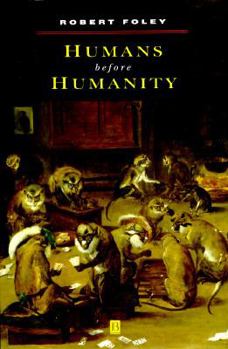Humans Before Humanity
Select Format
Select Condition 
Book Overview
This book recreates the lost world of the hominid species that lived and flourished for around one million years before, and in some cases after, the evolution of modern humans some 200,000 years ago. This description may be from another edition of this product.
Format:Hardcover
Language:English
ISBN:0631170871
ISBN13:9780631170877
Release Date:January 1997
Publisher:Blackwell Publishers
Length:256 Pages
Weight:1.15 lbs.
Dimensions:1.0" x 6.2" x 9.2"
Customer Reviews
2 ratings
Totally Intellectual Creation-the book that is
Published by Thriftbooks.com User , 21 years ago
Robert Foley has produced a work of utmost brilliance. Humans before Humanity is thoroughly engaging to both the general reader (myself included) and to the novice in the fields of anthropology, palaeontology, evolutionist, primatologist, geneticist and others. The book is entirely refreshing in its approach and in the discussion of theories relating to the origins, developments, morphology and extinction of the humans before humanity-the common ancestors of modern humans.The book is organised in a novel (at least to me) way of answering pertinent questions relating to humans. These are questions like, among others, What are human beings; Why Africa; Why are humans so rare in evolution. Each chapter is an intellectual journey with highly scientific approaches, with ample evidences and empirical basis. One such theoretical discussion was on the developments of the large human brains. He summoned theories relating to sociality of the apes (human ancestors) to explain why humans evolved large brains. He also gave a statistical discussion on co-relation of brain size (and all the other mathematical methods of measuring brain size) to sociality. What was most interesting and enlightening was a cost and benefit analysis of large brains, explaining why other apes do not have brains as large as humans, if such large brains were so beneficial.Throughout the book, especially the later part, Foley summons the cost and benefit approach to explain most characteristics of humans. This is a highly structured way of making sense of the most perplexing questions relating to human evolution. It was the economics of evolution. He also used this approach to explain why other animals did not evolve the way humans did. This approach was used in explaining bipedalism, hominid reproduction, hominid social complexes and others.The last chapter, I feel, is the chapter worth reading more than any other books in anthropology and evolution. The last chapter answers the question: Does evolution really matter? He sums up the book by exploring the origins of language, culture and cognition. The most annoying yet important debate of nature vs nurture (biology vs culture) is also treated albeit in a brief way and not revealing any bias to one side. His last discussion is a cogent intellectual call to separate consequences from causes. He argues that human evolution has been highly magnificent and even grand-like because of the benefit of hindsight. But it does not warrant grand causes like creationist theories, aquatic theories and other blinding-flash theories, which gave man what he has today. His coup de grace in this scientifically intellectual book, is by saying that during the course of human evolution, "nothing very much happened". In the plethora of books with the purpose of introducing the reader with the latest theories of human evolution, this book ranks as one of the best. Foley is careful to focus squarely on fossils and scientific theories and not on magnificently w
Great coverage of current & fringe anthropology theories
Published by Thriftbooks.com User , 22 years ago
Foley manages to say quite a bit in this 200 page book about anthropology, evolution, and a little about sociology too. He addresses not only the mainstream but some peripheral issues as well. All in all he covers a wide range of issues intelligently and resourcefully. The text is harmoniously augmented and complimented by great graphics and charts as well, rendering what I thought was an informative, entertaining, and credible exposition of an often dry and soporific subject matter.The other reviewer who rates this book one star was obviously way over reacting to some comments by Foley in the opening pages of the book that address the scientifically outdated Boas/Mead SSSM (Standard Social Science Model). This book's strength should be measured by its anthropological relevancy, not the brief, although likely accurate assessment of a paradigm shift away from obsolete social theories toward the more current genetically based models, which is more of a fait accompli than a debate. Foley's pot shots at literary post modernist meddling in the hard sciences is certainly not unwarranted, nor is his de rigour lecture about the idiocy of the religious right verses biological evolution. These are two pretty common and valid criticisms.Foley does join the status quo and endorse the out of Africa theory, but does give some air time to the likes of Van Daniken and the more credible but still fringe Elaine Morgan. He does this I think to contrast how much has been learned and set into a defined scientific context about the still swampy opaqueness that temporal extension tends to create in anthropology, especially in light of the more anthropocentric critics and cranks that this particular science naturally attracts.In any event, he proceeds, workman like, to cover the known artifactual and statistical data regarding bipedalism, its concomitant anatomical morphology, classification schemas & lineages, tool usage, radiations, African Eve, allometric neural evolution, etc. I particular enjoyed his discussion of allometric neural evolution and the encephalization quotient statistical model, and their correlation to intelligence relative to the putative survival characteristics of now extinct hominids.Foley sums up with the cultural considerations of art, langauge, and agriculture. He poses all of his survey in an evolutionary context and never wavers from a most scientific consideration of all the material he analyzes. This book is a thorough, fast paced perusal of anthropology as it stands today (or in 1995 as it were) and helped me to syncretize what can be a daunting ocean of a most dense and often impenetrable science.





